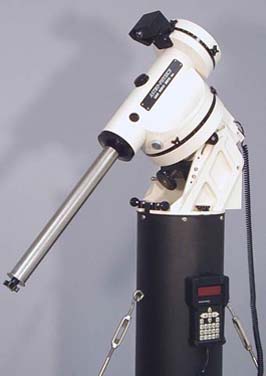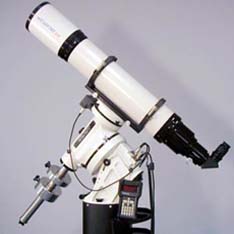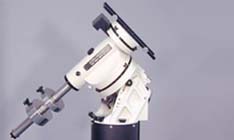ASTRO-PHYSICS
HISTORY
1200GTO German Equatorial Mount (1200GTO)
with GTOCP2 Control Box
Includes Go-to Keypad Controller and DigitalSky Voice™ software
The 1200GTO
German Equatorial Mount with the GTOCP2 Control
Box is not available to purchase. The information below is provided for
present owners and those who are curious about its history. It is based on
the original information with a few updates. If
you are interested in some of the earlier or later models, check out this Brief
History of the 1200 German Equatorial.
Click here for an interactive view of the 1200GTO mount
Click photos for more informationWith the advent of the CCD camera, amateurs are exploring the skies to an ever increasing level of precision, easily exceeding the image quality of large observatories using film techniques decades ago. This new level puts a higher demand on the precision of the equatorial mounting. Many of the finest imagers today have been using our GTO mounts as a solid platform for a wide variety of instruments. The largest of these is our 1200GTO.
Since its introduction in 1998, the 1200GTO has gained a
reputation for both tracking and pointing accuracy, essential to casual visual
observation as well as advanced imaging. Quite a few 1200GTO and 900GTO mounts
can be found at Mount Pinos in California, favorite observing site of many
advanced photographers and imagers.
These mounts are truly a marvel of engineering - maximum strength and rigidity with minimum weight. Our CNC lathes and mills carve out the excess material in both axes of the 1200 and 900 German Equatorials while retaining a heavily ribbed structure for internal strength and rigidity. A unique dovetail was machined into the mating surfaces of the R.A. and Dec axes. This feature allows quick and easy assembly in the field without any tools.
The 1200 equatorial is equally at home in a permanent observatory or as a portable mounting for remote star parties thanks to the ease with which the two axes come apart. You CAN have it all. This is the perfect mount for a large refractor, Newtonian, Cassegrain or astrograph. Telescopes commonly used include Astro-Physics 155-206mm refractors, 12-14" Schmidt-Cassegrains and 10-16" Ritchey-Chretiens.
The 1200GTO mount is built from the ground up to be a precision imaging platform while still remaining totally user friendly. Consider these advantages and features:
Flexibility
Portable.
Extremely solid, rugged, high payload mount, yet comes apart in two reasonably light-weight components for hassle-free field setup. No tools needed to assemble
the mount in the field.
Operate with 12V battery.
You can take it to the darkest skies and power it with a commonly available 12V battery. In the observatory, we suggest a minimum 5 amp filtered, regulated power
supply.
External computer not needed.
The keypad is a handheld computer with all of the features, functions and databases you need to tour the universe night after night. The unique software allows you to precisely polar align your mount in the field, even in broad daylight! The vacuum-fluorescent display with a temperature range of -40 degrees F (and C, they are the same in this instance), allows hardy observers to use this mount on cold
winter nights. You can't do that with a PC!
Separate computer control.
All functions of the servo drive can be commanded from a laptop or desktop computer using popular planetarium software. Depending on the features of the program, you can position your telescope, center your image and control tracking rate, remote focusing, reticle brightness and park at the end of your observing session.
Examples of currently available software:
- Software Bisque's suite which includes TheSky Astronomy Software, CCDSoft CCD Astronomy Software, TPoint Telescope Pointing Analysis Software and Orchestrate Scripting Software.
- Earth Centered Universe (ECU) by David Lane of Nova Astronomics
- SkyMap Pro 6 by Chris Marriot
- DigitalSky Voice from Astro-Physics by Charles Sinsofsky (included with the 1200GTO)
Write your own computer program.
The Astro-Physics
GTO protocol for the GTOCP2 Control Box is freely
available to those who would like to write their own
computer program for controlling the mount. While based
on the Meade protocol, it has many more features and
enhanced precision level which allows pointing and tracking
to the 1 arc second level.
Precise Mechanical Fabrication.
Highly accurate mechanics.
Using modern CNC machining techniques, we make all components to a high precision level which results in a final package that is solid and accurate in all respects. The critical angles are accurately machined so that the mount is orthogonal to a very high degree. This results in pointing accuracies well below 1 arc minute
for a properly aligned mount.
Worm gear accuracy.
Critical worm gear accuracy
is maintained by special machining techniques developed
at Astro-Physics after extensive studies and actual
field operation. Our worm accuracies are second to none.
With good alignment, PEM training with the Keypad or
PEMPro
software, it is quite practical now to achieve unguided
CCD images with today's hi-resolution cameras coupled
to a 6" to 16" telescope.
Mechanical Features
- All machined mounting made from aluminum barstock and stainless steel. All fasteners are stainless steel.
- Motors and all electronic components are enclosed.
- Each shaft is supported by 5 bearing elements, two preloaded ball bearings and 3 sets of massive thrust bearings. The result is very low friction, which is constant with the load.
- 18" removable 1.875" diameter counterweight shaft can hold up to six 18 lb. counterweights and one 10 lb. counterweight.
- Polar and declination axes come apart quickly without tools for light-weight, easy handling and ease of transport.
- Fine altitude and azimuth adjustments for quickly and accurately zeroing in on the pole in the field.
- Engraved setting circles are Porter Slip Ring Design.
- Electronic components rated for industrial and automotive applications.
- Base fits into 10" diameter pier with 0.094" wall thickness.
Specifications of Equatorial Head
| R.A. worm wheel |
10.3" (26.2cm), 225 tooth aluminum |
| Declination worm wheel |
7.2" (18.3cm), 225 tooth aluminum |
| Worm gears |
Brass |
| R.A. shaft |
3.35" (8.5cm) diameter |
| R.A. thrust bearings |
9.5" (24.1cm) diameter |
| Dec. shaft |
2.36" (6.0cm)diameter |
| Dec. thrust bearings |
6.5" (16.5cm) diameter |
| Latitude range |
20 to 68 degrees |
| Azimuth adjustment |
Approximately 14 degrees |
| Right ascension |
4-minute increments, pointer, engraved both |
| Declination |
1 degree increments, engraved, pointer |
| Setting circles |
Porter Slip Ring design, engraved, pointer |
| Capacity |
Approximately 140 lb. (63.6kg) scope and accessories, depending on length. Will accommodate Astro-Physics and similar refractors up to 206mm f8, 16" Cassegrains and Ritchey-Chretiens
Some telescopes are very heavy for their size and will require a larger mount. |
| Weight of equatorial head |
91 lbs. (41.4kg), Dec axis is 30 lbs. (13.6kg), RA axis is 47 lbs. (21.4kg), counterweight shaft is 14 lbs. (6.4kg) |
Servo Motor Drive
The drive system uses a high-quality Swiss DC servo motor
controlled by a microprocessor to an accuracy of 0.05 arc seconds per step.
Tracking is very smooth, noticeably smoother than any stepper motor drive or
inexpensive servo drive. The system can be accurately controlled over a speed
range of 4800:1 which allows 0.25x sidereal for guiding to 1200x sidereal for
5 degree per second. The circuit draws only 0.4 amps when tracking the stars,
2 amps with both motors slewing and requires only 12 volts to operate. This
servo drive will satisfy the requirements of the sophisticated, advanced astrophotographer,
yet is easy for the casual, visual observer to use.
Dimensions
 |
The diagram shows several dimensions that are commonly requested. In addition, if the scope is horizontal and pointing west or south, the measurement from the top of the pier to the middle of the cradle plate is 11.25." Please note that these dimensions will vary somewhat depending on your latitude. We quote them for 42 degrees because that is the latitude of Astro-Physics and all of our equipment is set up that way. It is also a good average value.
Please refer to this PDF document of you are planning an observatory and need to know the variations in the horizontal distance from the center of the mount base plate to the center of the declination axis that are caused by different latitude settings. Note that the mount pictured has the polar forks introduced in 2004, however, as shown in the document, the dimensions are the same. |
Support
We have prepared some pertinent support documents relating to this mount and many of our other products on our Technical Support page. Please check there first to find the information that you need.
Upgrades and Spare Parts
Check out our Astro-Physics.com website to find accessories, replacement parts or learn about possible upgrades for your mount.
Copyright © 1999-2019, Astro-Physics,
Inc. - All Rights Reserved
This page was last modified:
March 11, 2019
Astro-Physics, Inc.
11250 Forest Hills Road, Rockford, IL 61115, U.S.A.
Phone: 815-282-1513 Fax: 815-282-9847



